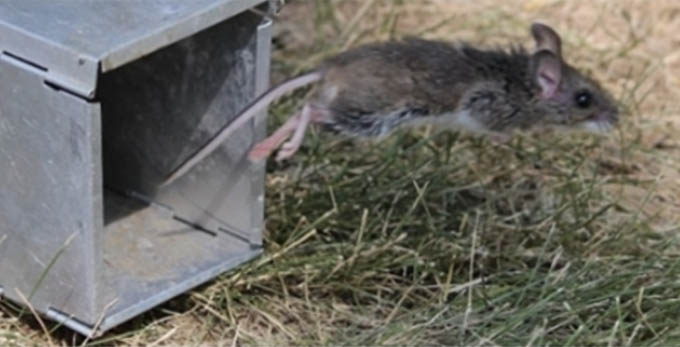Each spring, as rodents emerge from their burrows, Four Corners residents cleaning out storage sheds or woodpiles know to be on the lookout for tiny deer mice, which can carry the deadly Sin Nombre hantavirus.
Steven Bradfute, PhD, an associate professor in The University of New Mexico Center for Global Health and Department of Internal Medicine, and an expert in virology, immunology and microbiology, has spent years teasing out the secrets of the virus, which kills nearly 40% of those who become infected.
In recently published research, Bradfute and his colleagues have developed new gene sequencing methods to confirm the presence of hantavirus, discovered that the virus may also be carried by other rodent species, including house mice, brush mice, white-footed mice, piñon mice and chipmunks, and even identified a potential therapy for an illness that, until now, has had no cure.
“We have a lot of interesting things going on,” Bradfute says.
More than 20 types of rodent-borne hantavirus have been identified around the world. Old World strains of the virus cause hemorrhagic fever and kidney disease, while the New World varieties lead to serious cardiopulmonary symptoms, Bradfute says.
In the case of the Sin Nombre virus, first identified following an outbreak in the Southwest in 1993, the primary treatment of severe disease involves placing a patient on heart-lung bypass using extracorporeal membrane oxygenation (ECMO) to help them survive the infection.
In a paper published recently in the journal Viruses, Bradfute and colleagues in his lab and the UNM Museum of Southwest Biology reported that they have developed a tool that uses reverse-transcription quantitative real-time polymerase chain reaction technology to rapidly screen the tissue of wild-caught rodents for the presence of hantavirus.
“We have a set of assays that targets any hantavirus,” Bradfute says. In the Southwest, the new tool will enable scientists to quickly determine whether the disease is being carried by species other than deer mice – until now the only species known to transmit the Sin Nombre virus to humans.
Preliminary evidence shows that multiple species do carry the virus, in addition to deer mice. In a paper published last fall in the Journal of Virology, Bradfute and colleagues, including PhD student Sam Goodfellow and research scientists Robert Nofchissey and Chunyan Ye in the Bradfute lab, reported on the case of a 57-year-old rancher in northern New Mexico who had fallen ill with the hantavirus.
Investigators trapped a number of different rodents at the man’s house and at another site about 15 miles away. “We tested them all for the presence of Sin Nombre virus genes,” Bradfute says. Genes from the virus, found in lung tissue, were present in several different rodent species besides deer mice, meaning it is more ubiquitous in the environment than previously believed.
One theory is that this could be the result of “spillover,” in which one rodent species becomes infected by coming into contact with another, Bradfute says.

We’re seeing [hantavirus] pretty frequently in rodents that are not deer mice. Can they transmit the virus as well? That’s the subject of active study in our lab
“We’re seeing it pretty frequently in rodents that are not deer mice,” he says. “Can they transmit the virus as well? That’s the subject of active study in our lab.”
And while previous hantavirus cases have been concentrated in the Four Corners region, Bradfute says it appears that rodents elsewhere in New Mexico also carry the Sin Nombre strain. “Why is it that most infections are in the northwest corner of the state?” he asks. “We are working on a couple of papers now to answer that question.”
Bradfute notes that even if rodent populations carrying the hantavirus are more widespread than previously believed, “The infection rate for Sin Nombre is still very, very low. Either the virus doesn’t transmit well, or there has be certain variations to transmit it to humans.”
In another new paper published in Science Translational Medicine, Bradfute joined an international consortium of investigators led by Kartik Chandran, PhD, professor of microbiology and immunology at Albert Einstein College of Medicine, that identified a monoclonal antibody that appears to provide broad protection against both Old and New World strains of hantavirus.
The antibodies were originally isolated from Swedish patients who had been exposed to an Old World hantavirus, he said. Studies in the lab suggested that the antibodies were protective against both Old and New World forms of the virus.
“It’s fairly surprising,” Bradfute says. “The two sets of viruses cause a different type of disease and they use different receptors to enter cells. To have one antibody that works with both is pretty amazing.”
Translating the new finding into treatments and vaccines to protect against hantavirus infection is likely to be a way off. In the meantime, people can take a page from the COVID-19 pandemic to reduce the risk of becoming infected.
“The N95 mask is what you want to wear,” Bradfute says. “A properly fitted N95 offers a lot of protection against hantavirus.”
